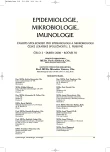Medium with Amikacin for Laboratory Diagnosis of Beta-haemolytic Streptococci
Půda s amikacinem k záchytu beta-hemolytických streptokoků
Beta-hemolytické streptokoky se uplatňují jako etiologické agens sekundárních infekcí ran, ulcerací a dekubitů. Jejich laboratorní diagnostika bývá komplikována tím, že se na infekci často podílejí i další, růstově méně náročné bakterie (Staphylococcus aureus, pseudomonády a enterobakterie). Ty na krevním agaru přerůstají kolonie beta-hemolytických streptokoků.
Byl srovnán záchyt beta-hemolytických streptokoků na krevním agaru a na selektivním krevním agaru s přídavkem amikacinu (36 μg/ ml).
Celkem bylo vyšetřeno 836 vzorků od 782 pacientů. Zachyceno bylo 86 izolátů beta-hemolytických streptokoků. V 73 případech byly identifikovány další bakteriální druhy podílející se na infekci. Nejčastěji to byl S. aureus a Pseudomonas aeruginosa. U vzorků, kde byla zjištěna smíšená infekce, bylo 46 izolátů beta-hemolytických streptokoků zachyceno jak na krevním agaru, tak na krevním agaru s amikacinem. Dalších 27 izolátů bylo zachyceno pouze na krevním agaru s amikacinem. Bez použití selektivní půdy by uniklo 37 % izolátů beta-hemolytických streptokoků u vzorků z kožních lézí.
Klíčová slova:
beta-hemolytické streptokoky – sekundární kožní infekce – selektivní půda.
Authors:
M. Dvořáková Heroldová; M. Dvořáčková
Authors‘ workplace:
Mikrobiologický ústav LF MU a FN u sv. Anny v Brně
Published in:
Epidemiol. Mikrobiol. Imunol. 55, 2006, č. 2, s. 73-75
Overview
Beta-haemolytic streptococci are implicated in the etiology of secondary wound infection, ulcerations and decubitus ulcers. Laboratory diagnosis of these causative agents is complicated by the fact that other less fastidious bacteria (Staphylococcus aureus, pseudomonads and enterobacteria) may also be involved in the infection. On blood agar, these bacteria overgrow colonies of beta-haemolytic streptococci.
Detectability of beta-haemolytic streptococci on blood agar and selective blood agar added with amikacin (36 μg/ ml) was compared.
A total of 836 specimens from 782 patients were examined. Eighty-six isolates of beta-haemolytic streptococci were detected.
Coinfection with other bacterial species, most frequently identified as Staphylococcus aureus and Pseudomonas aeruginosa, was observed in 73 specimens. Forty-six isolates of beta-hemolytic streptococci involved in coinfection were detected on both blood agar and blood agar with amikacin.
Twenty-seven additional isolates were only recovered on blood agar with amikacin. Without the use of selective medium, 37 % of isolates of beta-haemolytic streptococci from skin lesion specimens would escape detection.
Key words:
beta-haemolytic streptococci – secondary skin infection – selective medium.
Labels
Hygiene and epidemiology Medical virology Clinical microbiologyArticle was published in
Epidemiology, Microbiology, Immunology

2006 Issue 2
Most read in this issue
- West Nile Virus
- Medium with Amikacin for Laboratory Diagnosis of Beta-haemolytic Streptococci
- Outbreak of Marburg Hemorrhagic Fever in Angola
- Epidemiological Characteristics of Diabetes Mellitus in Slovakia, 1992–2002
